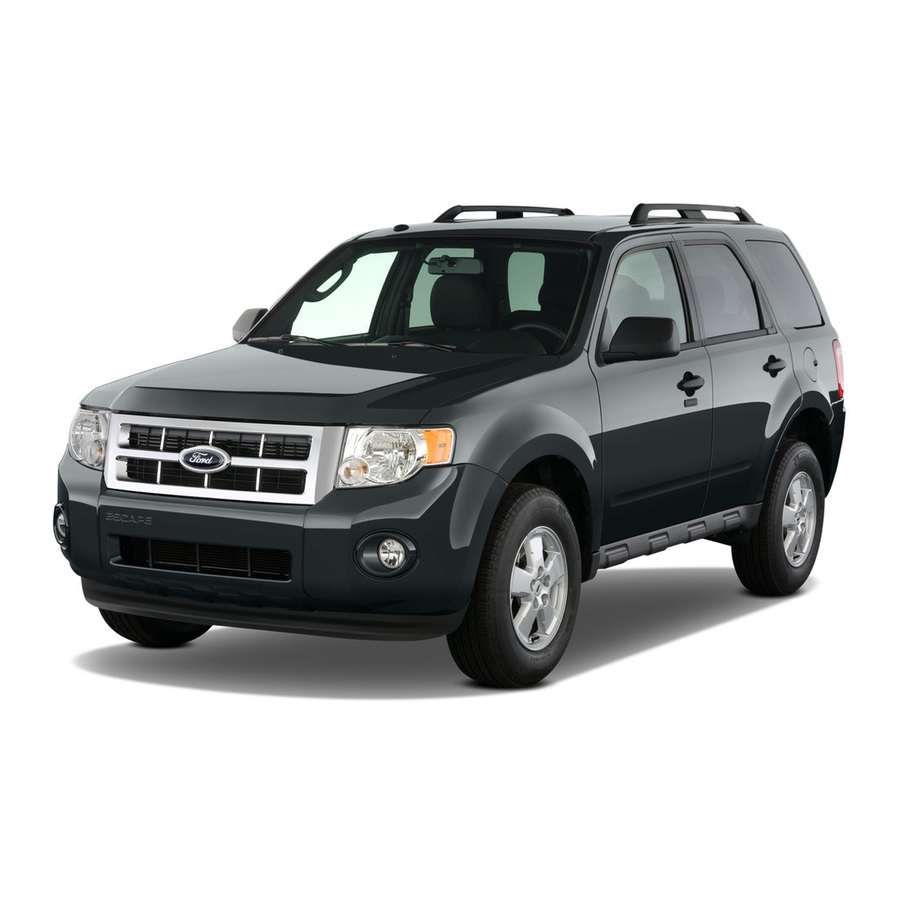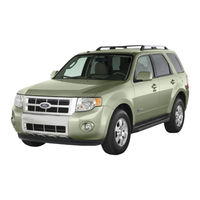
Ford 2009 Escape Manuals
Manuals and User Guides for Ford 2009 Escape. We have 4 Ford 2009 Escape manuals available for free PDF download: Owner's Manual, Quick Reference Manual
Ford 2009 Escape Owner's Manual (321 pages)
Brand: Ford
|
Category: Automobile
|
Size: 2 MB
Table of Contents
-
-
-
-
Safety Belt14
-
Door Ajar16
-
Turn Signal16
-
Gauges17
-
-
-
AM/FM Radio21
-
Load22
-
RDS Radio22
-
Eject23
-
-
-
-
Lights
45 -
-
-
Window Lock64
-
Bounce-Back72
-
Reset73
-
Info Menu73
-
Setup Menu74
-
System Check75
-
Oil Life76
-
Autolamp Sec76
-
Autolock77
-
Autounlock77
-
Language77
-
Liftgate80
-
Luggage Rack82
-
-
Keys85
-
Front Seats102
-
-
-
Seating102
-
Rear Seats108
-
Head Restraints108
-
-
Belt-Minder122
-
One-Time Disable125
-
-
-
Treadwear163
-
Tires164
-
Damage167
-
Tire Care167
-
Tire Wear167
-
Highway Hazards170
-
Safety Practices170
-
Tire Rotation171
-
-
Base Curb Weight183
-
Payload183
-
Cargo Weight185
-
Trailer Towing189
-
Preparing to Tow191
-
Hitches192
-
Safety Chains192
-
Trailer Brakes192
-
Trailer Lamps192
-
-
Driving
196-
Starting196
-
Brakes201
-
Using ABS202
-
ABS Warning Lamp202
-
Parking Brake203
-
Steering210
-
Using the Clutch215
-
Reverse216
-
Sand221
-
Mud and Water222
-
Advertisement
Ford 2009 Escape Owner's Manual (310 pages)
Brand: Ford
|
Category: Automobile
|
Size: 2 MB
Table of Contents
-
Lights
43-
Headlamps43
-
-
-
-
Seating99
-
Airbags124
-
Child Restraints139
-
-
-
Tire Information154
-
Tire Inflation156
-
Vehicle Loading175
-
Trailer Towing181
-
-
Driving
188 -
-
Fuses and Relays222
-
Changing Tires229
-
Jump Starting241
-
Wrecker Towing247
Ford 2009 Escape Quick Reference Manual (2 pages)
Ford Automobile Quick Reference Guide
Brand: Ford
|
Category: Automobile
|
Size: 1 MB
Table of Contents
Advertisement
(Spanish) Ford 2009 Escape Owner's Manual (676 pages)
Brand: Ford
|
Category: Automobile
|
Size: 6 MB
Table of Contents
-
Indicadores17
-
Puerto USB34
-
Espejos71
-
-
-
Asientos112
-
Bolsas de Aire157
-
-
Manejo
220-
Arranque220
-
Frenos226
-
Advancetrac229
-
-
Limpieza
293 -
Accesorios
347-
Índice349
-
Introduction359
-
Cell Phone Use363
-
-
Fuel Gauge373
-
Speedometer373
-
Odometer374
-
Tachometer374
-
Trip Odometer374
-
Audio System375
-
-
AM/FM Radio376
-
Direct376
-
Memory Presets376
-
CD/MP3 Player377
-
RDS Radio377
-
Eject378
-
Play/Pause378
-
Scan378
-
Seek/Track378
-
Compression379
-
Text379
-
Tune/Ok379
-
Category Menu381
-
Song Seek Menu381
-
Extra Features383
-
Climate Controls393
-
Operating Tips395
-
Manual Operation398
-
Lights400
-
Headlamps404
-
Interior Lamps404
-
Bulb Replacement406
-
Driver Controls412
-
Center Console416
-
Accessory Delay419
-
Window Lock419
-
Exterior Mirrors420
-
With Microphone420
-
To Vent427
-
Info Menu428
-
Reset428
-
Setup Menu429
-
System Check430
-
Autolamp Sec431
-
Oil Life431
-
Language432
-
System Warnings432
-
Liftgate435
-
Luggage Rack437
-
-
-
Power Door Locks442
-
Autounlock444
-
Car Finder448
-
Illuminated Exit451
-
Automatic Arming454
-
Front Seats457
-
-
Head Restraints463
-
Rear Seats463
-
-
Belt-Minder477
-
One-Time Disable480
-
Airbags485
-
-
Treadwear518
-
Tires519
-
Damage522
-
Tire Care522
-
Tire Wear522
-
Highway Hazards525
-
Safety Practices525
-
Tire Rotation526
-
H528
-
R528
-
M+S or M/S529
-
Maximum Load529
-
-
Base Curb Weight538
-
Payload538
-
Cargo Weight540
-
Trailer Towing544
-
Driving551
-
Starting551
-
Brakes556
-
ABS Warning Lamp557
-
Using ABS557
-
Parking Brake558
-
Steering565
-
R (Reverse)568
-
L (Low)569
-
Using the Clutch570
-
Reverse571
-
Sand576
-
Mud and Water577
-
Fuses and Relays583
-
Jump Starting602
-
Wrecker Towing608
-
Emergency Towing609
-
Cleaning618
-
Exterior Chrome618
-
Paint Chips619
-
Waxing619
-
2.5L I4620
-
Engine620
-
Interior623
-
Underbody624
-
-
-
Opening the Hood627
-
2.5L I4 Engine628
-
Battery636
-
Severe Climates641
-
Fuel Filter643
-
Refueling645
-
Cleaner Air648
-
Fuel Quality648
-
Filling the Tank650
-
Conditions652
-
Maintenance652
-
High Fluid Level657
-
Low Fluid Level657
-
Air Filter658
-
Engine Data664
-
Index669



